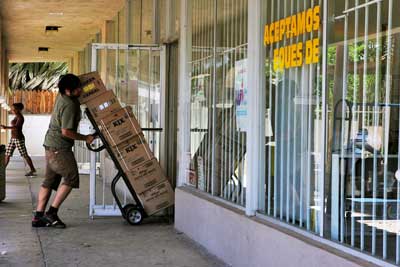
Federal WIC program rewriting voucher menu to add fruit, vegetables, more fish
 |
Download story podcast | |
08:23 PM PDT on Monday, May 26, 2008
A federal food voucher program for low-income women and children is in the midst of its first major overhaul in nearly 30 years, allowing for the first time purchases of fruits and vegetables and whole grain foods.
Nutritionists and advocacy groups have hailed the changes to the $6 billion Special Supplemental Nutrition Program for Women, Infants and Children, familiarly known as WIC, as an important step in fighting both malnutrition and obesity among society's neediest families. Right now, the vouchers can buy only dairy products, juices, cereal, infant formula and a few other items.
The changes come at a time when enrollment in the WIC program is surging in the Inland region and other parts of the country because of the lackluster economy, high rate of home foreclosures and soaring food and gas prices.

WIC agencies in Riverside and San Bernardino counties saw their combined enrollment climb to 162,375 last month, and the gain put each about 5,000 over its capacity. Program managers said they have scaled back their advertising, although they emphasized that no one who is eligible is being turned away.
"We take the funding we have, and we stretch ourselves," said Betsy Cline, San Bernardino County's WIC program manager.
Established 35 years ago, the WIC program is overseen by the U.S. Department of Agriculture.
The federal government recently distributed an additional $150 million from a WIC contingency fund, and the agriculture secretary authorized the release of another $150 million from a food stamp contingency fund to deal with the growing demand.
Food Choices Expand
The program targets low-income pregnant women, breastfeeding women, new mothers and their children age 5 and younger.
In addition to food vouchers, program participants get access to nutrition education and counseling at WIC clinics.
In California, the average value of monthly food vouchers is $63, which can be used to purchase designated amounts of cereal, juice, milk, cheese, eggs, peanut butter, tuna and infant formula.
WIC vouchers are accepted at 400 stores in Riverside and San Bernardino counties, ranging from large chain stores, such as Ralphs, Albertsons and Stater Bros., to small independent vendors that cater only to WIC clients.
These WIC-only stores operate differently from regular grocery stores in that all food items are displayed behind a counter. An employee helps the WIC client select and bag the desired food items.
Nutritionists, advocacy groups and others lobbied the federal government to expand the program's food options to accommodate the growing ethnic diversity of WIC clients and to combat a worsening obesity epidemic.
A survey of California WIC participants in 2007 found that about two-thirds were Hispanic. And a 2003 state report found that more than one-third of children in the WIC program were overweight or at risk for obesity, in line with overall health trends in the community.
Following recommendations by the Institute of Medicine, the USDA announced in December that it was adding fruits and vegetables, tortillas, brown rice and other whole grains, soy beverages, tofu, canned salmon and sardines to the voucher program.
In order to keep program costs level, the government reduced the amount of juice, milk, cheese and eggs that can be purchased, although the amounts are still in line with dietary guidelines recommended by the American Academy of Pediatrics.
States have until Oct. 1, 2009, to adopt the changes. The delay is meant to give states time to educate local WIC agencies about the changes and to give vendors time to add the new products to their inventories.
"We're excited. It's got some good nutrition. It offers diversity," said Gayle Hoxter, Riverside County's WIC program manager. "We hope it'll make a difference in how families eat."
Picking up eggs, milk and Kix cereal last week at Nutritional Merchandise, a nondescript WIC-only vendor tucked away in a San Bernardino strip mall, Veronica Weiss said she welcomes the additional food choices.
"A lot of those items are very expensive," said Weiss, 27, who has a 3-year-old daughter and recently enrolled in the program. "Healthy food has a bigger price tag."

Funding
Nearly 50 percent of WIC food expenses go toward milk, cheese and eggs, and prices for those items have shot up 14 to 31 percent over the past year, according to the Center on Budget and Policy Priorities in Washington, D.C., a nonprofit that researches policies and programs that affect low- and moderate-income families.
Rising food costs and surging demand are putting a strain on the program in some states.
Every year, the federal government gives money to each state to reimburse stores for WIC food purchases and to pay for nutrition counseling and education provided by local WIC agencies.
Missouri announced last month that it was barring purchases of name-brand cereals and juices in order to save costs.
"As Missouri families make adjustments when food prices rise, we are making similar adjustments in WIC to make sure our food budget stretches as far as possible," Lyn C. Konstant, chief of that state's WIC program, said in a statement.
Linnea Sallack, chief of the California WIC branch, said she doesn't anticipate the need for such restrictions. Although WIC enrollment has risen in the Inland region, it has declined in other areas of California, she said.
In addition, the state relies on other sources of funding, including a rebate program in which the state works out a deal with a food manufacturer to provide only that manufacturer's brand to WIC participants. In return, the state gets money back each time that item is purchased, she said.
Reach Douglas Quan at 951-368-9479 or dquan@PE.com
Food Vouchers
The Special Supplemental Nutrition Program for Women, Infants and Children -- the federal food program familiarly known as WIC -- is revising its voucher system to encourage better nutrition and to accommodate ethnic diversity.
Allowed now
Cereal
Juice
Milk
Cheese
Eggs
Peanut butter
Tuna
Infant formula
To be added (Effective Oct. 1,
2009, at the latest)
Tortillas
Brown rice
Whole grains
Soy beverages
Tofu
Sardines
Canned salmon
Fruits
Vegetables
Mobile news, boards, & newsletters
Subscribe to local news e-mail alerts
Other Inland News
Redlands orchestra rolls out the welcome mat
Latino immigrants sending less money home; other signs of financial stress mount
Lake Elsinore girl's short film selected to air on Qubo Channel
Ponti brothers share stage at next San Bernardino symphony concert
Sacramento newbie brings experience, open mind to tough political landscape
Local Videos
Latest Photo Galleries
Popular Stories















You must be logged in to contribute. Log in | Register Now!
You are logged in as screenname | Log Out
You are logged in, but do not have a "screen" name. Update Your Profile